elizabeth 1伊利莎白一世英文介绍
Elizabeth I of England
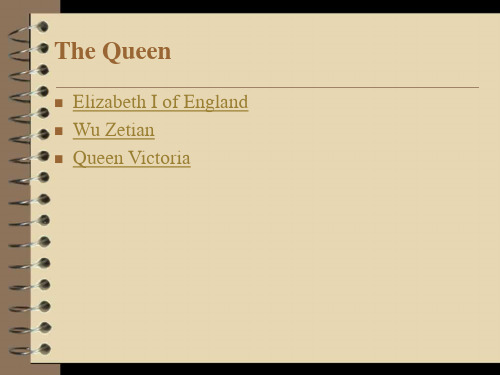
Wu Zetian
。武曌(624年2月17日-705年12月16日),亦作武瞾、武照,本名不详,通称武则天或武后,并州文水人, 中国历史上“唯一”得到普遍承认的女皇帝[注 4]。唐高宗时为皇后(655年-683年),尊号为天后,与唐高 宗李治并称二圣,683年12月27日-690年10月16日作为唐中宗、唐睿宗的皇太后临朝称制,后自立为武周皇 帝(690年10月16日-705年2月22日在位),705年退位以后,成为中国历史上唯一一位女性太上皇。 . Wu Zhao (624 February 17th - 705 December 16th), Wu, Wu according to years of age and also known as Wu Zetian, whose real name is unknown, or the Empress Wu, the state and people in Wenshui, the history of China "only" widely recognized female emperor [4]. Tang Gaozong queen (655 - 683), title for days, and Tang Gaozong Li Zhi are said to be the two st, 683 years in December 27th 690 years in October 16th as Tang Ruizong Tang Zhongzong, the empress dowager empress working as an emperor, self Wu Zhou Huangdi (690 October 16th - 705 February 22nd reign), 705 years after the abdication of, become Chinese history is the only female overlord. 武氏为唐开国功臣武士彟次女,母亲杨氏,祖籍并州文水县(今山西省文水县),生于长安(今陕西省西安 市),十四岁时因长得很美,而入后宫为唐太宗的才人,唐太宗赐号武媚[注 5]。高宗时为昭仪,后封为皇后, 又上尊号为“天后”。高宗崩,中宗即位,武氏为皇太后,临朝称制后改名曌[注 6]。武氏认为自己好像日、 月一样崇高,凌挂于天空之上。于称帝后上尊号“圣神皇帝”,退位后中宗上尊号“则天大圣皇帝”。武氏 另有废除的尊号“圣母神皇、圣神皇帝、金轮圣神皇帝、越古金轮圣神皇帝、慈氏越古金轮圣神皇帝、天册 金轮圣神皇帝、则天大圣皇帝”等。[1]Wu Tang founding hero Samurai Yue female, Young's mother, Bingzhou origin Wenshui county (now Shanxi Wenshui county), was born in Changan (today's Shaanxi Province, Xi'an city), at the age of fourteen who was beautiful, but the Tang Taizong lady, Tang Taizong grant, Wu Mei [5]. Gao Zongshi Zhao, after sealing the queen, and title as "days". The avalanche, Zhongzong ascended the throne, the empress dowager, Chao said the system later renamed Zhao [6]. Wu think himself as day, month as lofty, Ling hung in the sky above. To proclaim oneself emperor after the title of "emperor of the Holy Spirit", to step down after the title "the day God Emperor Zhongzong". The abolition of the title of "the Notre Dame, the spirit of the emperor, emperor of the Holy Spirit, the more ancient Jinlun Jinlun emperor of the Holy Spirit, Cheshire more ancient Jinlun emperor of the Holy Spirit, day book Jinlun emperor of the Holy Spirit, the day God Emperor" etc.. [1]
英国各个时期女王介绍英文

Anne of Great Britain (安妮女 王)(1664年-1714年)
Queen Anne (6 February 1665 – 1 August 1714[1]) ascended the thrones
of England, Scotland and Ireland on 8 March 1702. On 1 May 1707,
crowned on June 2, 1953. During her reign, she has tried to make the British monarchy more modern and
sensitive to the public.
January 1901,aged 81, having reigned for
sixty-three years, seven months and two days
(more than any British monarch before or
since).
Victoria's death brought an end to the rule of the House of Hanover in the United Kingdom. King Edward VII, like his father Prince Albert, belonged to the House of Saxe-Coburg
queen
There are totally seven queens in the UK.
Jane Grey Mary I Elizabeth Ⅰ Queen Mary Ⅱ Anne of Great Britain Victorian Elizabeth II
伊丽莎白一世(英文版ppt)
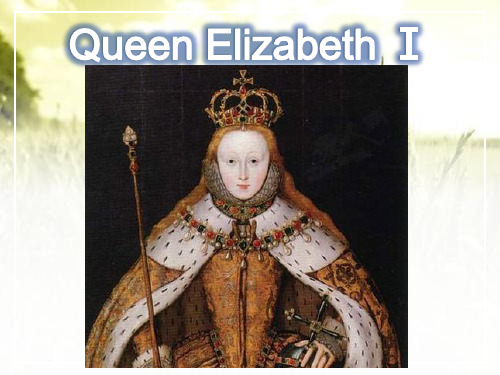
Elizabeth was born at Greenwich Palace and was named after both her grandmothers, Elizabeth of York and Elizabeth Howard. She was the second child of Henry VIII of England born in wedlock to survive infancy. Her mother was Henry's second wife,Anneiress presumptive to the throne of England. Her older half-sister, Mary, had lost her position as a legitimate heir when Henry annulled his marriage to Mary's mother, Catherine of Aragon, to marry Anne, with the intent to sire a male heir and ensure the Tudor succession. Elizabeth was baptised on 10 September; Archbishop Thomas Cranmer, the Marquess of Exeter, the Duchess of Norfolk and the Dowager Marchioness of Dorset stood as her godparents.
When she was young, she was unmarried. She has never refused or agreed with others’ pursuing. She took advantage of her unmarried indentity to deal with those crowns like Spanish﹑Roman Empire﹑France and Sweden without sincerity who chased her one after another , and to keep the right balance in the continent, especially between France and Spanish, for obtaining the maximal benefits of England. She considered herself to be married to England;calling her people “my husbands”.
伊丽莎白一世英文PPT简介presentation详细版

Elizabeth was a carefree small princess in the first three year.
In January 1536, Elizabeth's status was down a lot because of Boleyn’s death. In June 1536, the parliament declared to cancel her throne from qualification.
After the death of Boleyn, Henry viii successively took four wives, but only had one son, Edward. In 1547, Henry viii died, the son became the king.
1547 ,Edward acceded ,only in six years. The new king had a weak body, and suffering from tuberculosis. Therefore, the replacement of the throne was just a question of time.
She took a cautious attitude when dealing with the relationship with parliament.
She was very thrifty, but she was very positive to the prosperity of country, she relied on businessmen and pirates to increase the income of royal family.
伊丽莎白一世女王英文版
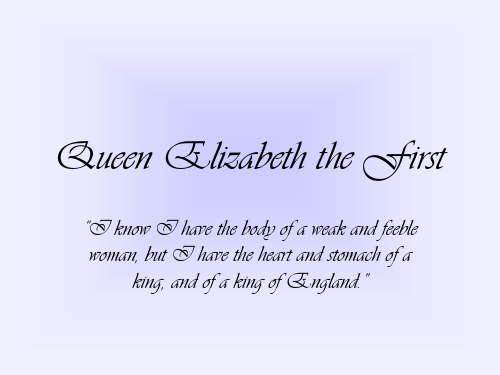
The Life of Queen Elizabeth I
Elizabeth Tudor was born on September 7, 1533 to King Henry VIII and his second wife Anne Boleyn. The Roman Catholics of England considered her an illegitimate child.
Accomplishments
• பைடு நூலகம்eveloped a compromise to please the Roman Catholic and the Protestant churches; probably saved England from religious wars
Accomplishments cont‟d
Queen Elizabeth the First
“I know I have the body of a weak and feeble woman, but I have the heart and stomach of a king, and of a king of England.”
A leader is…
Queen Elizabeth the First
In regards to her country and subjects, Queen Elizabeth I said, “There is no jewel, be it of never so high a price, which I set before this jewel; I mean your love.”
SAT人物写作素材之伊丽莎白一世

SAT人物写作素材之伊丽莎白一世Queen Elizabeth I 1533 1603Elizabeth I was queen of England and Ireland from 1558 to 1603. She preserved stability in a nation rent by political and religious dissension and maintained the authority of the Crown against the growing pressures of Parliament.Born at Greenwich, on September 7, 1533, Elizabeth I was the daughter of Henry VIII and his second wife, Anne Boleyn. Because of her fathers continuing search for a male heir, Elizabeths early life was precarious. In May 1536 her mother was beheaded to clear the way for Henrys third marriage, and on July 1, Parliament declared that Elizabeth and her older sister, Mary, the daughter of Henrys first queen, were illegitimate and that the succession should pass to the issue of his third wife, Jane Seymour. Jane did produce a male heir, Edward, but even though Elizabeth had been declared illegitimate, she was brought up in the royal household. She received an excellent education and was reputed to be remarkably precocious, notably in languages and music.Edward VI and MaryDuring the short reign of her brother, Edward VI, Elizabeth survived precariously, especially in 1549 when the principal persons in her household were arrested and she was to all practical purposes a prisoner at Hatfield. In this period she experienced ill health but pursued her studies under her tutor, Roger Ascham.In 1553, following the death of Edward VI, her sister Mary I came to the throne with the intention of leading the country back to Catholicism. The young Elizabeth found herself involved in the complicated intrigue that accompanied these changes. Withouther knowledge the Protestant Sir Thomas Wyatt plotted to put her on the throne by overthrowing Mary. The rebellion failed, and though Elizabeth maintained her innocence, she was sent to the Tower. After two months she was released against the wishes of Marys advisers and was removed to an old royal palace at Woodstock. In 1555 she was brought to Hampton Court, still in custody, but on October 18 was allowed to take up residence at Hatfield, where she resumed her studies with Ascham.。
英国各个时期女王介绍英文版
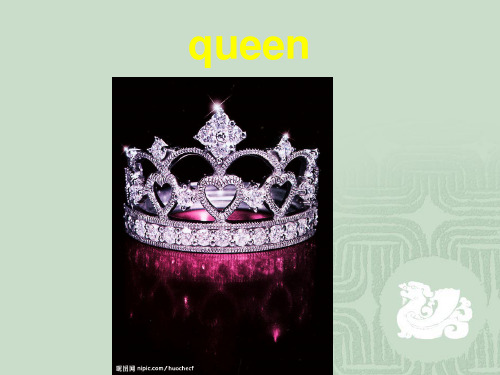
Anne of Great Britain (安妮女 王)(1664年-1714年)
Queen Anne (6 February 1665 – 1 August 1714[1]) ascended the thrones of England, Scotland and Ireland on 8 March 1702. On 1 May 1707, under the Act of Union, two of her realms, the kingdoms of England and Scotland, united as a single sovereign state: the united kingdom of Great Britain.
Queen Mary Ⅱ(玛丽二世)
She is King James Ⅱ’s daughter. Though she is a princess ,she does not observe all rules and regulations. She has a secret which is unknown. Actually, she is a lesbian. She loves a girl whose father works for the King and she expresses her love for the girl. She often call the girl “husband”. However their amour did not have a happy ending.
Elizabeth Ⅰ
Elizabeth : ( 7 September 1533 – 24 March 1603) ; the fifth and last monarch of the Tudor dynasty. Birth and parents: at Greenwich Palace; father: Henry VIII; mother: Anne Boleyn Marriage: Unmarried
伊利莎白一世(英语简介)

“时代的辉煌伴随着个人的辉煌,伊丽莎白女王一世是英国历史上最辉 煌的君主之一,她的时代也跻身于英国最辉煌的时代之列,但公众生活的辉 煌却以个人生活的黯淡为代价,伊丽莎白一世终生不嫁,其中的原因,就是 只有她终身不嫁,才能维护国家的统一,民族的和谐,从而保证都铎王朝的 繁荣昌盛。” ——《英国通史》 “她是一位天生实际的女性,商业触觉异常敏锐,一般女性罕见。” 世》 ——摘自《童贞女王:伊丽莎白一
Life line
Religion
Elizabeth set out to rule by good counsel, and she depended heavily on a group of trusted advisers led by William Cecil, Baron Burghley. One of her first moves as queen was the establishment of an English Protestant church, of which she became the Supreme Governor. This Elizabethan Religious Settlement later evolved into today's Church of England.
Queen Elizabeth I
演讲者:
Structure
① ② ③ ④ ⑤ ⑥ Brief Introduction Life Iine Religion Commercial Expansion The War with Spain Literature
Queen Elizabeth I
Elizabeth I was a queen of England and Ireland from 17 November 1558 until her death. Sometimes called "The Virgin Queen", "Gloriana" or "Good Queen Bess", Elizabeth was the fifth and last monarch of the Tudor dynasty. The daughter of Henry VIII, she was born a princess, but her mother, Anne Boleyn, was executed two and a half years after her birth, and Elizabeth was declared illegitimate.
品味历史:你不知道的伊丽莎白一世(双语)

品味历史:你不知道的伊丽莎白一世(双语)伊丽莎白一世简介伊丽莎白一世Elizabeth I(1533年9月7日出生于格林尼治,即今日伦敦的格林尼治,1603年3月24日逝世于萨里),于1558年11月17日至1603年3月24日任英格兰和爱尔兰女王,是都铎王朝的第五位也是最后一位君主。
她终身未嫁,因此被称为“童贞女王”。
The reign of Queen Elizabeth I is often referred to as The Golden Age of English history. Elizabeth was an immensely popular Queen, and her popularity has waned little with the passing of four hundred years. She is still one of the best loved monarchs, and one of the most admired rulers of all time. She became a legend in her own lifetime, famed for her remarkable abilities and achievements。
Elizabeth was dedicated to her country in a way few monarchs had been or have been since. Elizabeth had the mind of a political genius and nurtured her country through careful leadership and by choosing capable men to assist her. Elizabeth was a determined woman, but she was not obstinate. She listened to the advice of those around her, and would change a policy if it was unpopular。
伊丽莎白一世的一生 英语

伊丽莎白一世的一生英语Elizabeth I, Queen of England, was a remarkable ruler. She inherited the throne in a time of turmoil and uncertainty, yet she managed to steer the country towards stability and prosperity. Her reign is often seen as the golden age of English history.Born into a family of complex politics and power struggles, Elizabeth learned the game of the throne from a young age. She watched carefully as her siblings andparents vied for power, and she absorbed those lessons well. It was no surprise when she emerged as a strong-willed and determined queen.Elizabeth was a patron of the arts and culture. Under her reign, English literature flourished, with the likes of Shakespeare and Spenser producing some of their greatest works. She was also a lover of music and dance, and her palaces often echoed with the sounds of lively banquets and balls.But Elizabeth was also a shrewd politician. She knew how to play the game of diplomacy, balancing the powers of Europe while maintaining England's independence. She never married, and her "Virgin Queen" status became a symbol of her nation's autonomy.One of Elizabeth's greatest challenges was her relationship with her cousin, Mary, Queen of Scots. The two queens were distantly related but their fates were intertwined. Mary's claim to the English throne threatened Elizabeth's own power, and yet.。
伊丽莎白一世介绍-英文PPT课件

.
7
Marriage question
As she grew older, Elizabeth became famous for her virginity, and a cult grew up around her which was celebrated in the portraits, pageants and literature of the day.
.
5
she was born a princess, but her mother, Anne Boleyn, was executed three years after her birth, and Elizabeth was declared illegitimate.
.
6
Her brother, Edward VI, cut her out of the succession. His will, however, was set aside, and in 1558 Elizabeth succeeded her half-sister, the Catholic Mary, during whose reign she had been imprisoned for nearly a year on suspicion of supporting Protestant rebels.
Queen Elizabeth I
.
1
Queen Elizabeth I
"I know I have the body of a weak and feeble woman,but I have the heart and stomach
of a king, and of a king of England"
伊丽莎白一世英文介绍
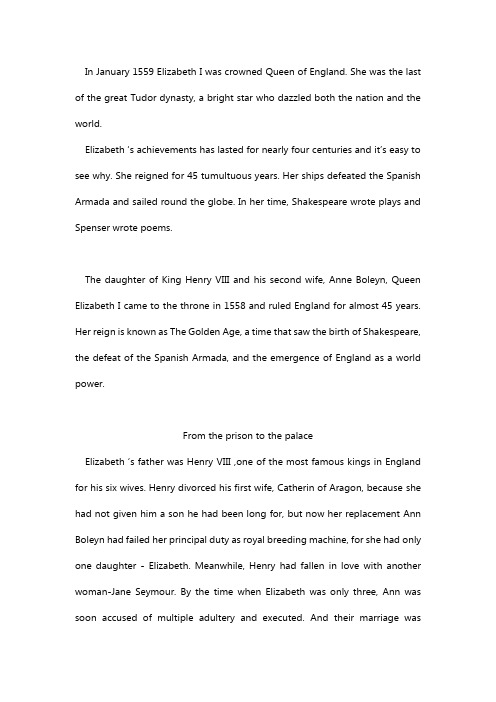
In January 1559 Elizabeth I was crowned Queen of England. She was the last of the great Tudor dynasty, a bright star who dazzled both the nation and the world.Elizabeth ‘s achievements has lasted for nearly four centuries and it’s easy to see why. She reigned for 45 tumultuous years. Her ships defeated the Spanish Armada and sailed round the globe. In her time, Shakespeare wrote plays and Spenser wrote poems.The daughter of King Henry VIII and his second wife, Anne Boleyn, Queen Elizabeth I came to the throne in 1558 and ruled England for almost 45 years. Her reign is known as The Golden Age, a time that saw the birth of Shakespeare, the defeat of the Spanish Armada, and the emergence of England as a world power.From the prison to the palaceElizabeth ‘s father was Henry VIII ,one of the most famous kings in England for his six wives. Henry divorced his first wife, Catherin of Aragon, because she had not given him a son he had been long for, but now her replacement Ann Boleyn had failed her principal duty as royal breeding machine, for she had only one daughter - Elizabeth. Meanwhile, Henry had fallen in love with another woman-Jane Seymour. By the time when Elizabeth was only three, Ann was soon accused of multiple adultery and executed. And their marriage wasdecleared null and void. Elizabeth was now illegitimate and unable to inherit the throne. So instead of the Right High and Mighty Princess, the Lady Elizabeth, inheritrix of the crown of England, she became the Lady Elizabeth, the King’s second bastard daughter. Although was brought up in the country away from the royal court, she studies languages from the age of four. She became fluent in French, Italian, Latin and Greek.In 1544, Henry reinstated Elizabeth and Mary in the succession. No woman had ever sat on the throne before. Now if Edward (Jane Seymour ’ s son) died without a heir, first Mary and then Elizabeth would become queen. Henry then sailed for France to fight a war, leaving his wife Katherine Parr, as regent in charge of the kingdom. Elizabeth now witnessed at first hand that an intelligent, well-educated woman could rule effectively.In 1546, Elizabeth’s father, Henry VIII died, and little King Edward VI had stepped into his father’s shoes at the age of 9, while Elizabeth was only 13.In order to divorce Catherin of Aragon, Henry had broken away from Rome and made himself head of the church in England. The Catholic churches ,crosses and candles were being stripped everywhere. The new faith had the enthusiastic backing of Elizabeth’s brother, the young King Edward. But by 1553, the 15-year-old King was dying of tuberculosis. He was desperate to stop the religious reforms being undone by his Catholic sister Mary, who would succed under the terms of their father’s will. So he excluded her from the succession because she was a bastard. But it couldn’t stop Mary’s overwhelming sup port, for she wasElizabeth had inherited from her sister Mary a nation that was bankrupt, military weak and hemmed in by enemies. In the parlance of the time, the country was a bone between two dogs - France and Spain.Elizabeth I - the last Tudor monarch - was born at Greenwich on 7 September 1533, the daughter of Henry VIII and his second wife, Anne Boleyn.Her early life was full of uncertainties, and her chances of succeeding to the throne seemed very slight once her half-brother Edward was born in 1537. She was then third in line behind her Roman Catholic half-sister, Princess Mary. Roman Catholics, indeed, always considered her illegitimate and she only narrowly escaped execution in the wake of a failed rebellion against Queen Mary in 1554.Elizabeth succeeded to the throne on her half-sister's death in November 1558. She was very well-educated (fluent in five languages), and had inherited intelligence, determination and shrewdness from both parents.Her 45-year reign is generally considered one of the most glorious in English history. During it a secure Church of England was established.Its doctrines were laid down in the 39 Articles of 1563, a compromise between Roman Catholicism and Protestantism.Elizabeth herself refused to 'make windows into men's souls ... there is only one Jesus Christ and all the rest is a dispute over trifles'; she asked for outward uniformity.Most of her subjects accepted the compromise as the basis of their faith, and her church settlement probably saved England from religious wars like those which France suffered in the second half of the 16th century.Although autocratic and capricious, Elizabeth had astute political judgement and chose her ministers well; these included William Cecil, later Lord Burghley (Secretary of State), Sir Christopher Hatton (Lord Chancellor) and Sir Francis Walsingham (in charge of intelligence and also a Secretary of State).Overall, Elizabeth's administration consisted of some 600 officials administering the great offices of state, and a similar number dealing with the Crown lands (which funded the administrative costs). Social and economic regulation and law and order remained in the hands of the sheriffs at local level, supported by unpaid justices of the peace.Elizabeth's reign also saw many brave voyages of discovery, including those of Francis Drake, Walter Raleigh and Humphrey Gilbert, particularly to the Americas. These expeditions prepared England for an age of colonisation and trade expansion, which Elizabeth herself recognised by establishing the East India Company in at the very end of 1599.The arts flourished during Elizabeth's reign. Country houses such as Longleat and Hardwick Hall were built, miniature painting reached itshigh point, theatres thrived - the Queen attended the first performance of Shakespeare's 'A Midsummer Night's Dream'. Composers such as William Byrd and Thomas Tallis worked in Elizabeth's court and at the Chapel Royal, St. James's Palace.The image of Elizabeth's reign is one of triumph and success. The Queen herself was often called 'Gloriana', 'Good Queen Bess' and 'The Virgin Queen'.Investing in expensive clothes and jewellery (to look the part, like all contemporary sovereigns), she cultivated this image by touring the country in regional visits known as 'progresses', often riding on horseback rather than by carriage. Elizabeth made at least 25 progresses during her reign.However, Elizabeth's reign was one of considerable danger and difficulty for many, with threats of invasion from Spain through Ireland, and from France through Scotland. Much of northern England was in rebellion in 1569-70. A papal bull of 1570 specifically released Elizabeth's subjects from their allegiance, and she passed harsh laws against Roman Catholics after plots against her life were discovered.One such plot involved Mary, Queen of Scots, who had fled to England in 1568 after her second husband, Henry, Lord Darnley's, murder and her subsequent marriage to a man believed to have been involved in his murder, James, Earl of Bothwell..As a likely successor to Elizabeth, Mary spent 19 years as Elizabeth's prisoner because Mary was the focus for rebellion and possible assassination plots, such as the Babington Plot of 1586.Mary was also a temptation for potential invaders such as Philip II. In a letter of 1586 to Mary, Elizabeth wrote, 'You have planned ... to takemy life and ruin my kingdom ... I never proceeded so harshly against you.' Despite Elizabeth's reluctance to take drastic action, on the insistence of Parliament and her advisers, Mary was tried, found guilty and executed in 1587.In 1588, aided by bad weather, the English navy scored a great victory over the Spanish invasion fleet of around 130 ships - the 'Armada'. The Spanish Armada was intended to overthrow the Queen and re-establish Roman Catholicism by conquest, as Philip II believed he had a claim to the English throne through his marriage to Mary.During Elizabeth's long reign, the nation also suffered from high prices and severe economic depression, especially in the countryside, during the 1590s. The war against Spain was not very successful after the Armada had been beaten and, together with other campaigns, it was very costly.Though she kept a tight rein on government expenditure, Elizabeth left large debts to her successor. Wars during Elizabeth's reign are estimated to have cost over £5 million (at the prices of the time) which Crown revenues could not match - in 1588, for example, Elizabeth's total annual revenue amounted to some £392,000.Despite the combination of financial strains and prolonged war after 1588, Parliament was not summoned more often. There were only 16 sittings of the Commons during Elizabeth's reign, five of which were in the period 1588-1601. Although Elizabeth freely used her power to veto legislation, she avoided confrontation and did not attempt to define Parliament's constitutional position and rights.Elizabeth chose never to marry. If she had chosen a foreign prince, he would have drawn England into foreign policies for his own advantages (as in her sister Mary's marriage to Philip of Spain); marrying a fellowcountryman could have drawn the Queen into factional infighting. Elizabeth used her marriage prospects as a political tool in foreign and domestic policies.However, the 'Virgin Queen' was presented as a selfless woman who sacrificed personal happiness for the good of the nation, to which she was, in essence, 'married'.Late in her reign, she addressed Parliament in the so-called 'Golden Speech' of 1601 when she told MPs: 'There is no jewel, be it of never so high a price, which I set before this jewel; I mean your love.' She seems to have been very popular with the vast majority of her subjects.Overall, Elizabeth's always shrewd and, when necessary, decisive leadership brought successes during a period of great danger both at home and abroad. She died at Richmond Palace on 24 March 1603, having become a legend in her lifetime. The date of her accession was a national holiday for two hundred years.。
伊丽莎白一世介绍英文
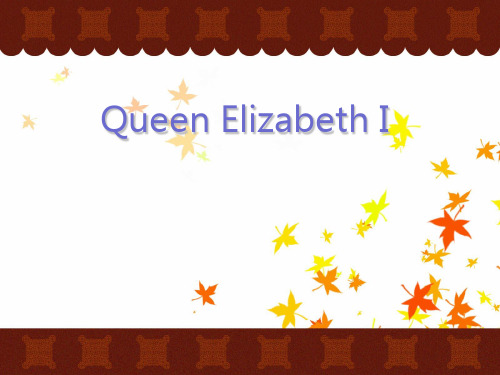
Queen Elizabeth I
Elizabeth I was a very sensible and precocious(早熟的) girl. She had a great talent of studying.
She did not marry because she wanted to protect England from foreign rule and civil war. Elizabeth insisted she was married to her kingdom and subjects under divine protection
Marriage question
As she grew older, Elizabeth became famous for her virginity, and a cult grew up around her which was celebrated in the portraits, pageants and literature of the day.
Queen Elizabeth I
Queen Elizabeth I
"I know I have the body of a weak and feeble woman,but I have the heart and stomach
of a king, and of a king of Englrincess, but her mother, Anne Boleyn, was executed three years after her birth, and Elizabeth was declared illegitimate.
伊丽莎白一世英文介绍
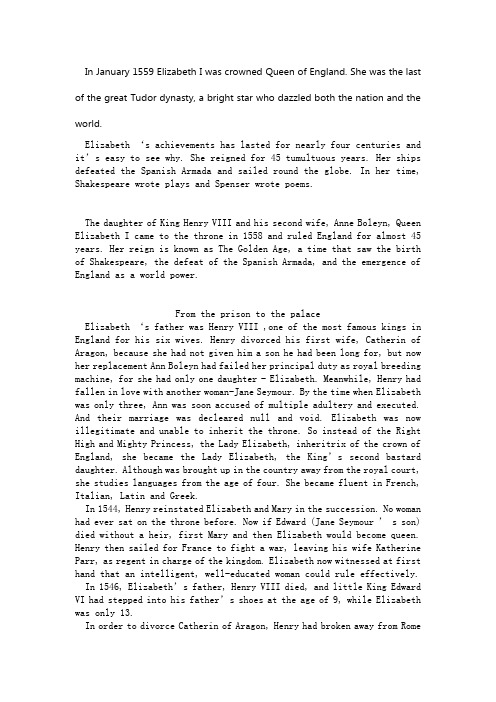
In January 1559 Elizabeth I was crowned Queen of England. She was the last of the great Tudor dynasty, a bright star who dazzled both the nation and the world.Elizabeth ‘s achievements has lasted for nearly four centuries and it’s easy t o see why. She reigned for 45 tumultuous years. Her ships defeated the Spanish Armada and sailed round the globe. In her time, Shakespeare wrote plays and Spenser wrote poems.The daughter of King Henry VIII and his second wife, Anne Boleyn, Queen Elizabeth I came to the throne in 1558 and ruled England for almost 45 years. Her reign is known as The Golden Age, a time that saw the birth of Shakespeare, the defeat of the Spanish Armada, and the emergence of England as a world power.From the prison to the palaceElizabeth ‘s father was Henry VIII ,one of the most famous kings in England for his six wives. Henry divorced his first wife, Catherin of Aragon, because she had not given him a son he had been long for, but now her replacement Ann Boleyn had failed her principal duty as royal breeding machine, for she had only one daughter - Elizabeth. Meanwhile, Henry had fallen in love with another woman-Jane Seymour. By the time when Elizabeth was only three, Ann was soon accused of multiple adultery and executed. And their marriage was decleared null and void. Elizabeth was now illegitimate and unable to inherit the throne. So instead of the Right High and Mighty Princess, the Lady Elizabeth, inheritrix of the crown of England, she became the Lady Elizabeth, the King’s second bastard daughter. Although was brought up in the country away from the royal court, she studies languages from the age of four. She became fluent in French, Italian, Latin and Greek.In 1544, Henry reinstated Elizabeth and Mary in the succession. No woman had ever sat on the throne before. Now if Edward (Jane Seymour ’ s son) died without a heir, first Mary and then Elizabeth would become queen. Henry then sailed for France to fight a war, leaving his wife Katherine Parr, as regent in charge of the kingdom. Elizabeth now witnessed at first hand that an intelligent, well-educated woman could rule effectively. In 1546, Elizabeth’s father, Henry VIII died, and little King Edward VI had stepped into his father’s shoes at the age of 9, while Elizabeth was only 13.In order to divorce Catherin of Aragon, Henry had broken away from Romeand made himself head of the church in England. The Catholic churches ,crosses and candles were being stripped everywhere. The new faith had the enthusiastic backing of Elizabeth’s brother, the young King Edward. But by 1553, the 15-year-old King was dying of tuberculosis. He was desperate to stop the religious reforms being undone by his Catholic sister Mary, who wo uld succed under the terms of their father’s will. So he excluded her from the succession because she was a bastard. But it couldn’t stop Mary’s overwhelming support, for she was proclaimed Queen ,whose vision was to lead England back to the true Catholic faith. Mary had stamped Catholicism on England with extraordinary violence, burning at the stake over 300 Protestant men, women, and children. Elizabeth’s Protestantism marked h er out as a potential enemy. In 1554, Elizabeth was sent to the tower for involving in a failed rebellion. However, Mary finally relented under pressure from her council to name Elizabeth as her successor. In 1559, Elizabeth was crowned as Queen of England.The Virgin QueenParliament petitioned the Queen asking her to pledge herself to a suitable international marriage. Three days later, she gave her responses. “Now the public care of governing the kingdom is laid upon me, to draw upon me also the cares of my marriage, may seem a point of inconsiderable folly. Yea, to satisfy you, I have already joined myself in marriage to an husband, namely the Kingdom of England. And for me it shall be a full satisfaction if, when I shall let my last breath, it may be engraven upon my marble tomb ’Here lieth Elizabeth, which reigned a virgin an d died a virgin’.”Elizabeth had finally got the parliament to restore Protestantism in England. Queen Elizabeth is God’s direct representative here on earth-church and state are one.Elizabeth had inherited from her sister Mary a nation that was bankrupt, military weak and hemmed in by enemies. In the parlance of the time, the country was a bone between two dogs - France and Spain.Elizabeth I - the last Tudor monarch - was born at Greenwich on 7 September 1533, the daughter of Henry VIII and his second wife, Anne Boleyn.Her early life was full of uncertainties, and her chances of succeeding to the throne seemed very slight once her half-brother Edward was born in 1537. She was then third in line behind her Roman Catholic half-sister, Princess Mary. Roman Catholics, indeed, always considered her illegitimate and she only narrowly escaped execution in the wake of a failed rebellion against Queen Mary in 1554.Elizabeth succeeded to the throne on her half-sister's death in November 1558. She was very well-educated (fluent in five languages), and had inherited intelligence, determination and shrewdness from both parents.Her 45-year reign is generally considered one of the most glorious in English history. During it a secure Church of England wasestablished. Its doctrines were laid down in the 39 Articles of 1563, a compromise between Roman Catholicism and Protestantism.Elizabeth herself refused to 'make windows into men's souls ... there is only one Jesus Christ and all the rest is a dispute over trifles'; she asked for outward uniformity.Most of her subjects accepted the compromise as the basis of their faith, and her church settlement probably saved England from religious wars like those which France suffered in the second half of the 16th century.Although autocratic and capricious, Elizabeth had astute political judgement and chose her ministers well; these included William Cecil, later Lord Burghley (Secretary of State), SirChristopher Hatton (Lord Chancellor) and Sir Francis Walsingham (in charge of intelligence and also a Secretary of State).Overall, Elizabeth's administration consisted of some 600officials administering the great offices of state, and a similar number dealing with the Crown lands (which funded the administrative costs). Social and economic regulation and law andorder remained in the hands of the sheriffs at local level, supported by unpaid justices of the peace.Elizabeth's reign also saw many brave voyages of discovery, including those of Francis Drake, Walter Raleigh and Humphrey Gilbert, particularly to the Americas. These expeditions prepared England for an age of colonisation and trade expansion, which Elizabeth herself recognised by establishing the East India Company in at the very end of 1599.The arts flourished during Elizabeth's reign. Country houses such as Longleat and Hardwick Hall were built, miniature painting reached its high point, theatres thrived - the Queen attended the first performance of Shakespeare's 'A Midsummer Night's Dream'. Composers such as William Byrd and Thomas Tallis worked in Elizabeth's court and at the Chapel Royal, St. James's Palace.The image of Elizabeth's reign is one of triumph and success. The Queen herself was often called 'Gloriana', 'Good Queen Bess' and 'The Virgin Queen'.Investing in expensive clothes and jewellery (to look the part, like all contemporary sovereigns), she cultivated this image by touringthe country in regional visits known as 'progresses', often riding on horseback rather than by carriage. Elizabeth made at least 25 progresses during her reign.However, Elizabeth's reign was one of considerable danger and difficulty for many, with threats of invasion from Spain through Ireland, and from France through Scotland. Much of northern England was in rebellion in 1569-70. A papal bull of 1570 specifically released Elizabeth's subjects from their allegiance, and she passed harsh laws against Roman Catholics after plots against her life were discovered.One such plot involved Mary, Queen of Scots, who had fled to England in 1568 after her second husband, Henry, Lord Darnley's, murder and her subsequent marriage to a man believed to have been involved in his murder, James, Earl of Bothwell..As a likely successor to Elizabeth, Mary spent 19 years as Elizabeth's prisoner because Mary was the focus for rebellion and possible assassination plots, such as the Babington Plot of 1586.Mary was also a temptation for potential invaders such as Philip II. In a letter of 1586 to Mary, Elizabeth wrote, 'You haveplanned ... to take my life and ruin my kingdom ... I never proceeded so harshly against you.' Despite Elizabeth's reluctance to take drastic action, on the insistence of Parliament and her advisers, Mary was tried, found guilty and executed in 1587.In 1588, aided by bad weather, the English navy scored a great victory over the Spanish invasion fleet of around 130 ships - the 'Armada'. The Spanish Armada was intended to overthrow the Queen and re-establish Roman Catholicism by conquest, as Philip II believed he had a claim to the English throne through his marriage to Mary.During Elizabeth's long reign, the nation also suffered from high prices and severe economic depression, especially in the countryside, during the 1590s. The war against Spain was not very successful after the Armada had been beaten and, together with other campaigns, it was very costly.Though she kept a tight rein on government expenditure, Elizabeth left large debts to her successor. Wars during Elizabeth's reign are estimated to have cost over £5 million (a t the prices of the time) which Crown revenues could not match - in 1588, for example, Elizabeth's total annual revenue amounted to some £392,000.Despite the combination of financial strains and prolonged war after 1588, Parliament was not summoned more often. There were only 16 sittings of the Commons during Elizabeth's reign, five of which were in the period 1588-1601. Although Elizabeth freely used her power to veto legislation, she avoided confrontation and did not attempt to define Parliament's constitutional position and rights.Elizabeth chose never to marry. If she had chosen a foreign prince, he would have drawn England into foreign policies for his own advantages (as in her sister Mary's marriage to Philip of Spain); marrying a fellow countryman could have drawn the Queen into factional infighting. Elizabeth used her marriage prospects as a political tool in foreign and domestic policies.However, the 'Virgin Queen' was presented as a selfless woman who sacrificed personal happiness for the good of the nation, to which she was, in essence, 'married'.Late in her reign, she addressed Parliament in the so-called 'Golden Speech' of 1601 when she told MPs: 'There is no jewel, be it of never so high a price, which I set before this jewel; I mean your love.'She seems to have been very popular with the vast majority of her subjects.Overall, Elizabeth's always shrewd and, when necessary, decisive leadership brought successes during a period of great danger both at home and abroad. She died at Richmond Palace on 24 March 1603, having become a legend in her lifetime. The date of her accession was a national holiday for two hundred years.。
伊丽莎白女王英文简介
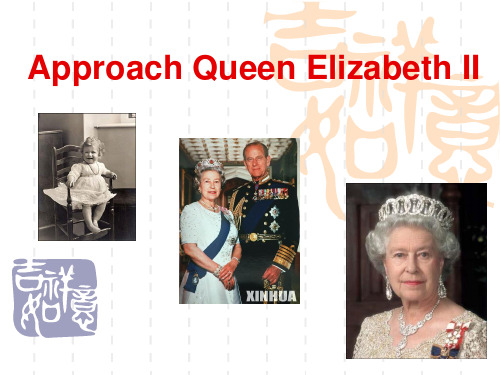
▪ As a constitutional monarch, Elizabeth has not expressed her personal political opinions in a public forum, maintaining this discipline throughout her reign.
Portrait of the queen,in 1933
Love & Marriage
▪ After a meeting at the Royal Naval College in July 1939, Elizabeth, though only 13 years old, fell in love with Philip, and they began to exchange letters.
Characteristic
▪ Elizabeth is known for her conservative fashions, consisting mostly of solid-colour overcoats and decorative hats, which allow her to be seen easily in a crowd. Out of the public eye, her main leisure interests include horse racing, photography, and dogs.
▪ Elizabeth II established numerous friendships, described as warm and informal, with foreign leaders.
▪ 13,10,1983
elizabeth 1伊利莎白一世英文介绍
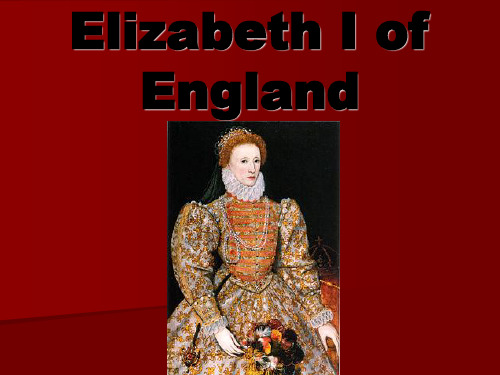
Elizabeth's reign is known as the Elizabethan era, era, famous above all for the flourishing of English drama, drama, led by playwrights such as William Shakespeare and Christopher Marlowe, and for the seafaring prowess of Marlowe, English adventurers such as Sir Francis Drake. Some Drake. historians are more reserved in their assessment. They depict Elizabeth as a short-tempered, sometimes shortindecisive ruler, who enjoyed more than her share of luck. Towards the end of her reign, a series of economic and military problems weakened her popularity. Elizabeth is acknowledged as a charismatic performer and a dogged survivor, in an age when government was ramshackle and limited and when monarchs in neighbouring countries faced internal problems that jeopardised their thrones. Such was the case with Elizabeth's rival, Mary, Queen of Scots, whom she Scots, imprisoned in 1568 and eventually had executed in 1587. After the short reigns of Elizabeth's brother and sister, her 44 years on the throne provided welcome stability for the kingdom and helped forge a sense of national identity.
Elizabeth伊丽莎白人物英文赏析
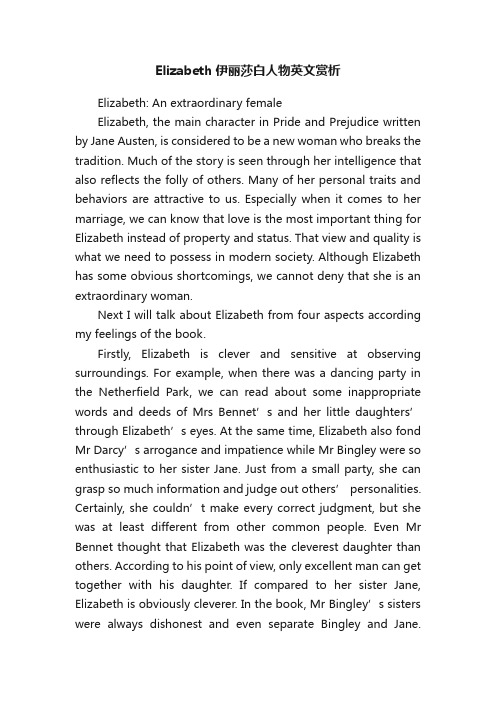
Elizabeth伊丽莎白人物英文赏析Elizabeth: An extraordinary femaleElizabeth, the main character in Pride and Prejudice written by Jane Austen, is considered to be a new woman who breaks the tradition. Much of the story is seen through her intelligence that also reflects the folly of others. Many of her personal traits and behaviors are attractive to us. Especially when it comes to her marriage, we can know that love is the most important thing for Elizabeth instead of property and status. That view and quality is what we need to possess in modern society. Although Elizabeth has some obvious shortcomings, we cannot deny that she is an extraordinary woman.Next I will talk about Elizabeth from four aspects according my feelings of the book.Firstly, Elizabeth is clever and sensitive at observing surroundings. For example, when there was a dancing party in the Netherfield Park, we can read about some inappropriate words and deeds of Mrs Bennet’s and her little daughters’ through Elizabeth’s eyes. At the same time, Elizabeth also fond Mr Darcy’s arrogance and impatience while Mr Bingley were so enthusiastic to her sister Jane. Just from a small party, she can grasp so much information and judge out others’ personalities. Certainly, she couldn’t make every correct judgment, but she was at least different from other common people. Even Mr Bennet thought that Elizabeth was the cleverest daughter than others. According to his point of view, only excellent man can get together with his daughter. If compared to her sister Jane, Elizabeth is obviously cleverer. In the book, Mr Bingley’s sisters were always dishonest and even separate Bingley and Jane.Readers can find out this fact early through some small details. So was Elizabeth. But Jane was so kind and stupid that she didn’t accept the truth. I always believe that being good at observing and thinking can find something unexpected just like Elizabeth.Secondly, Elizabeth loved her families and cared them very much. That’s largely moved me. In the 18th or 19th century, the main attention of the society was paid to property and status. In Pride and Prejudice, we can fortunately find some true love between families, especially Elizabeth. When Mrs Bennet could n’t wait to send Jane to Netherfield Park, which made Jane got ill, Elizabeth were not afraid of 3 miles walking to look after Jane. She even didn’t care about others’ astonished eyes and her own awkward appearance. Her coming made everyone surprised and unbelievable because they seldom fond such a different female like Elizabeth around their living environment. It was Elizabeth’s care to her sister that made Darcy find out her beauty. In addition to that, in dealing with Lydia’s marriage, she also tried her best to support her sister by sending her private savings. At that time, the quality was precious. In modern city, not only the west but also China increasingly felt the weak affection. The altruistic love Elizabeth showed is enough to make readers moved. “Love is priceless” is reflected incisively and vividly by Elizabeth.Thirdly, Elizabeth had independent mind and broke traditional concept. Living in that society, women didn’t have any rights to be educated. Some ladies occasionally can have the opportunity to study, but they just read a little modern Chinese in orderto have topic to communicate with men and make them notfall behind. In fact, these ladies don’t have real talents. However, Elizabeth thought that women should read more books and gain more knowledge. From the novel, Elizabeth was a female with rebellious spirit and betrayed ladies’ implicit principles. In all so rts of situations, she spoke lively language and liked laughing others. And every debate between her and Darcy ended in her victory. So Darcy was impressed by her wisdom and distinctive ideas and his love was established on the basis of real abilities of observation and judgment. So Elizabeth, the Cinderella, has subverted the traditional image and has the significance of the times.Fourthly, Elizabeth broke the social class concept and pursuit the equality. At the last 18th century and the early 19th century, the social class system was strict and the marriage needed to consider about property and status. A middle-class and less property intellectual woman, like Elizabeth, want to get a decent life and status, the only way is to marry a good man. But that’s not Elizabeth’s opinion. When Mr Collins wanted to marry her, she refused firmly no matter what benefits Collins would provide. When Mr Darcy wanted to marry her, she also refused firmly because she thought Darcy was an arrogant and impolite man and she didn’t fall in love with Darcy. When Mrs Catherine persuaded her to leave Darcy away, she still refused and decided to marry Darcy because she had loved Darcy very much regardless of social class. Love is equal for every sincere person.It’s difficult to imagine that Elizabeth could find her true love in such an era. She was not a perfect woman and she had much prejudice against Dar cy before she learned Darcy’s real personality. But that’s can’t hide her charm and beauty. The happy ending is also the wish of Jane Austen. In conclusion, whenwe pursuit our true love, do not be afraid of any unknown difficulties. To tell you the truth, the power of love can overcome everything.。
- 1、下载文档前请自行甄别文档内容的完整性,平台不提供额外的编辑、内容补充、找答案等附加服务。
- 2、"仅部分预览"的文档,不可在线预览部分如存在完整性等问题,可反馈申请退款(可完整预览的文档不适用该条件!)。
- 3、如文档侵犯您的权益,请联系客服反馈,我们会尽快为您处理(人工客服工作时间:9:00-18:30)。
Elizabeth set out to rule by good counsel,and she depended heavily on a group of trusted advisers led by William Cecil, Baron Burghley. One of her first moves as queen was the establishing of an English Protestant church, of Governor. which she became the Supreme Governor. This Elizabethan Religious Settlement later evolved into today's Church of England. It was expected England. that Elizabeth would marry and produce an heir so as to continue the Tudor line. She never did, however, despite numerous courtships. As she grew older, Elizabeth became famous for her virginity, and a cult grew up around her which was celebrated in the portraits, pageants, and literature of the day. day.
Elizabeth was cautious in foreign affairs, moving between the major powers of France and Spain. She only half-heartedly supported a number of halfineffective, poorly resourced military campaigns in the Netherlands, France and Ireland. In the midmid-1580s war with Spain could no longer be avoided, and when Spain finally decided to invade and conquer England in 1588, the defeat of the Spanish Armada associated her with what is popularly viewed as one of the greatest victories in English history. history.
In government, Elizabeth was more moderate than her father, brother and sister had been. One of her mottoes was "video et taceo" ("I see, and say nothing"). nothing").
Elizabeth I of England
Brief indrouctions Government Religion Foreign affair commeptember 1533 – 24 March 1603) was queen regnant of England and Ireland from 17 November 1558 until her death. Sometimes called The Virgin Queen, Gloriana, or Good Queen Bess, Queen, Gloriana, Bess, Elizabeth was the fifth and last monarch of the Tudor dynasty. dynasty. The daughter of Henry VIII, she was born a VIII, princess, but her mother, Anne Boleyn, was executed Boleyn, two and a half years after her birth, and Elizabeth was declared illegitimate. Her half-brother, Edward VI, halfVI, bequeathed the crown to Lady Jane Grey, cutting his Grey, halfhalf-sisters out of the succession. His will was set aside, Lady Jane Grey was executed, and in 1558 Elizabeth succeeded the Catholic Mary I, during whose reign she I, had been imprisoned for nearly a year on suspicion of supporting Protestant rebels.
Elizabeth's reign is known as the Elizabethan era, era, famous above all for the flourishing of English drama, drama, led by playwrights such as William Shakespeare and Christopher Marlowe, and for the seafaring prowess of Marlowe, English adventurers such as Sir Francis Drake. Some Drake. historians are more reserved in their assessment. They depict Elizabeth as a short-tempered, sometimes shortindecisive ruler, who enjoyed more than her share of luck. Towards the end of her reign, a series of economic and military problems weakened her popularity. Elizabeth is acknowledged as a charismatic performer and a dogged survivor, in an age when government was ramshackle and limited and when monarchs in neighbouring countries faced internal problems that jeopardised their thrones. Such was the case with Elizabeth's rival, Mary, Queen of Scots, whom she Scots, imprisoned in 1568 and eventually had executed in 1587. After the short reigns of Elizabeth's brother and sister, her 44 years on the throne provided welcome stability for the kingdom and helped forge a sense of national identity.
In religion she was relatively tolerant, tolerant, avoiding systematic persecution. After 1570, when the pope declared her illegitimate and released her subjects from obedience to her, several conspiracies threatened her life. All plots were defeated, however, with the help of her ministers' secret service. service.
